Whenever pig heads came into the kitchen I always squealed with joy. The act of taking a whole hog's head and turning it into a piece of charcuterie I've sold for $16 a slice is a magical process and a fading tradition of nose to tail eating. I learned to make it at Heartland, a legendary farm to table restaurant run by Chef Lenny Russo. Today I'll show you how to make your own head cheese (fromage de tete in French) from a pig head at home.
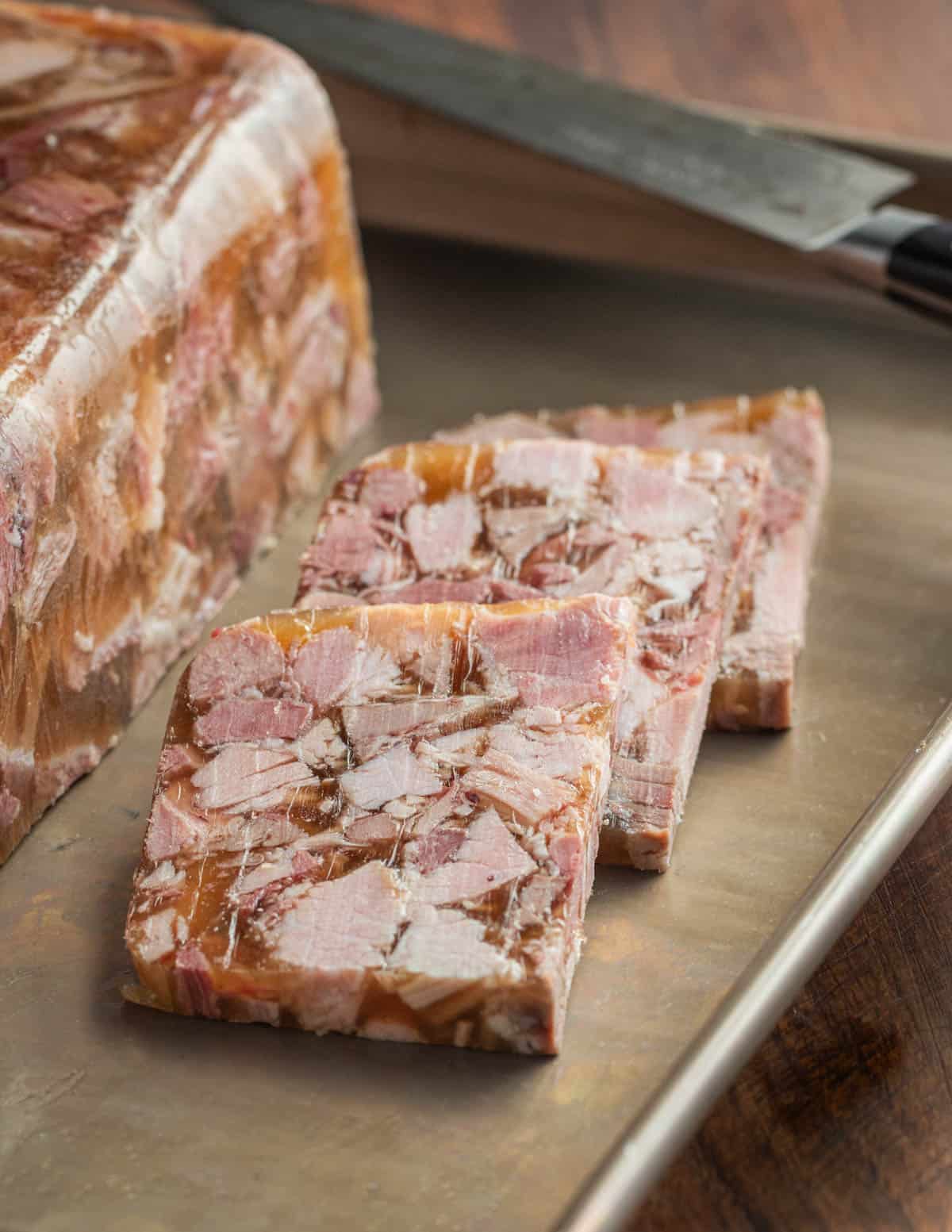
What is Head Cheese?
Simply put, headcheese is brine-cured, cooked meat from a pig head mixed with its reduced cooking liquid and packed into a loaf mold. The cooking liquid is rich in collagen that firms when cooled, making it a sort of meat jelly meatloaf.
Head cheese tastes mildly spiced and porky like ham. It does not have a gamey iron flavor to it like liver. Think of it like the best pork lunch meat you've ever had.

It's a good example of the great food inspired from frugality and different cuts of meat where nothing goes to waste. When it's made correctly it's a work of art, with a mosaic pattern resembling a stained glass window of pork.
Headcheese Ingredients
First you need a pork head, preferably sawed in half by a butcher so you can get at all the tidbits and secret chambers of the head.
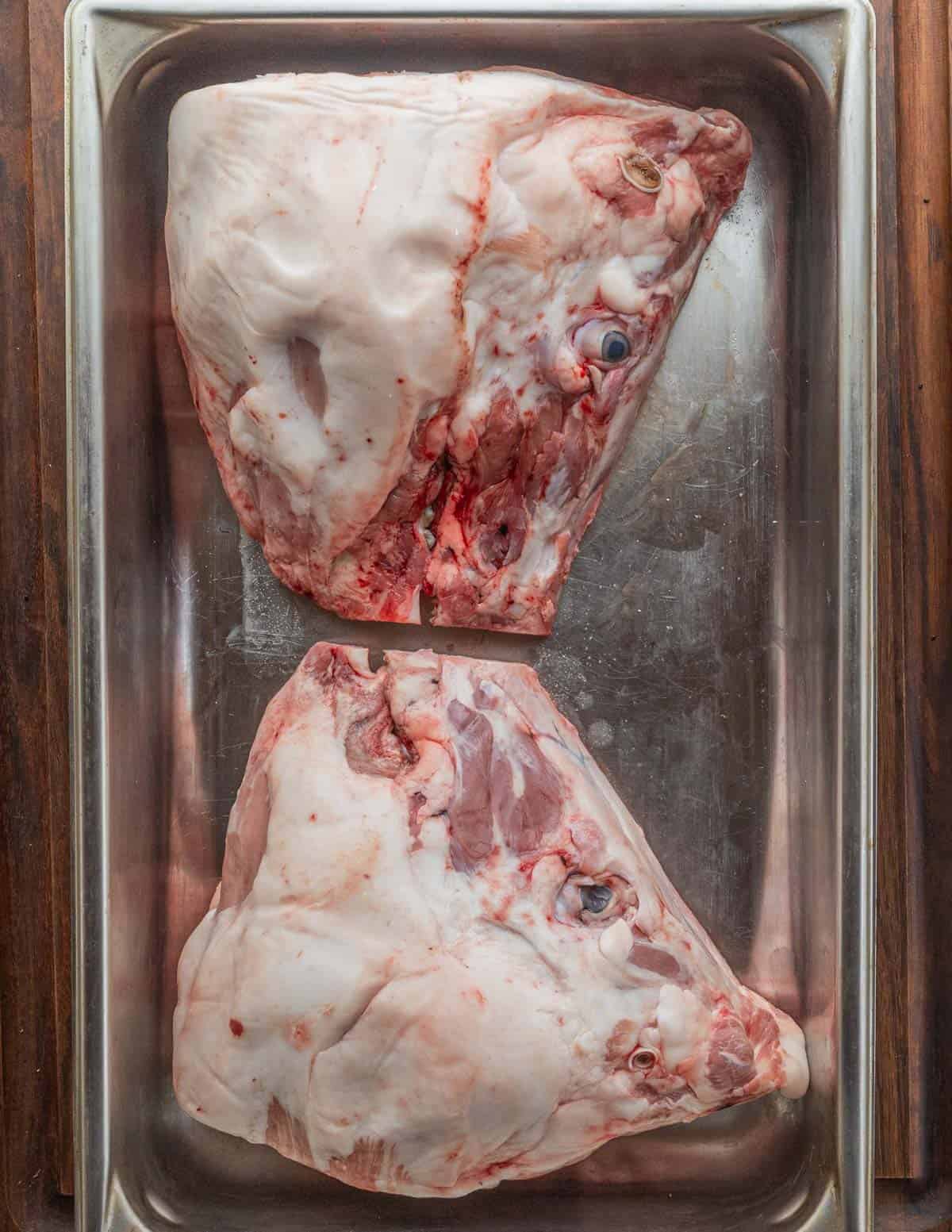
Besides heads, you can also use other cuts of pork like shanks or hocks. You'll want to call a butcher or a pig farmer for a fresh or frozen hog head.

Optional ingredients are a tongue, and pork trotters. And you'll need time as it takes at about 3 days to make headcheese.
You'll be knuckle deep in pig face, peeling meat from a skull like a cave person. But, if you do it well, you will have some serious bragging rights among your friends who know their charcuterie.
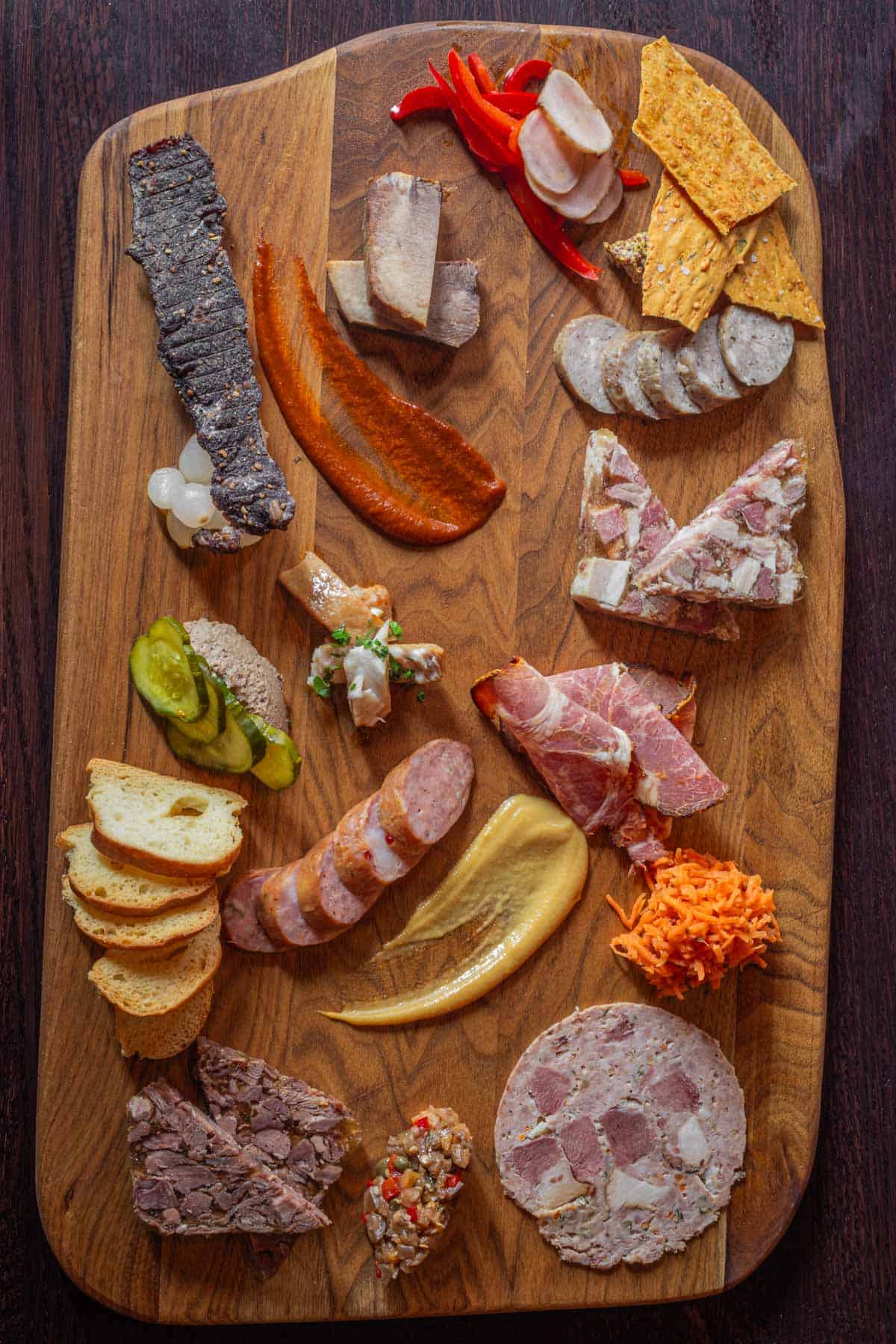
How to Make Headcheese (Step-by-Step)
There's a few steps: brining the pig head, cooking and picking the meat. Lastly, you reduce the liquid to concentrate the gelatin and pack the headcheese into a mold. The images below describe the process.
Brining
First the bring is cooked and chilled, then poured over the halved pig head.
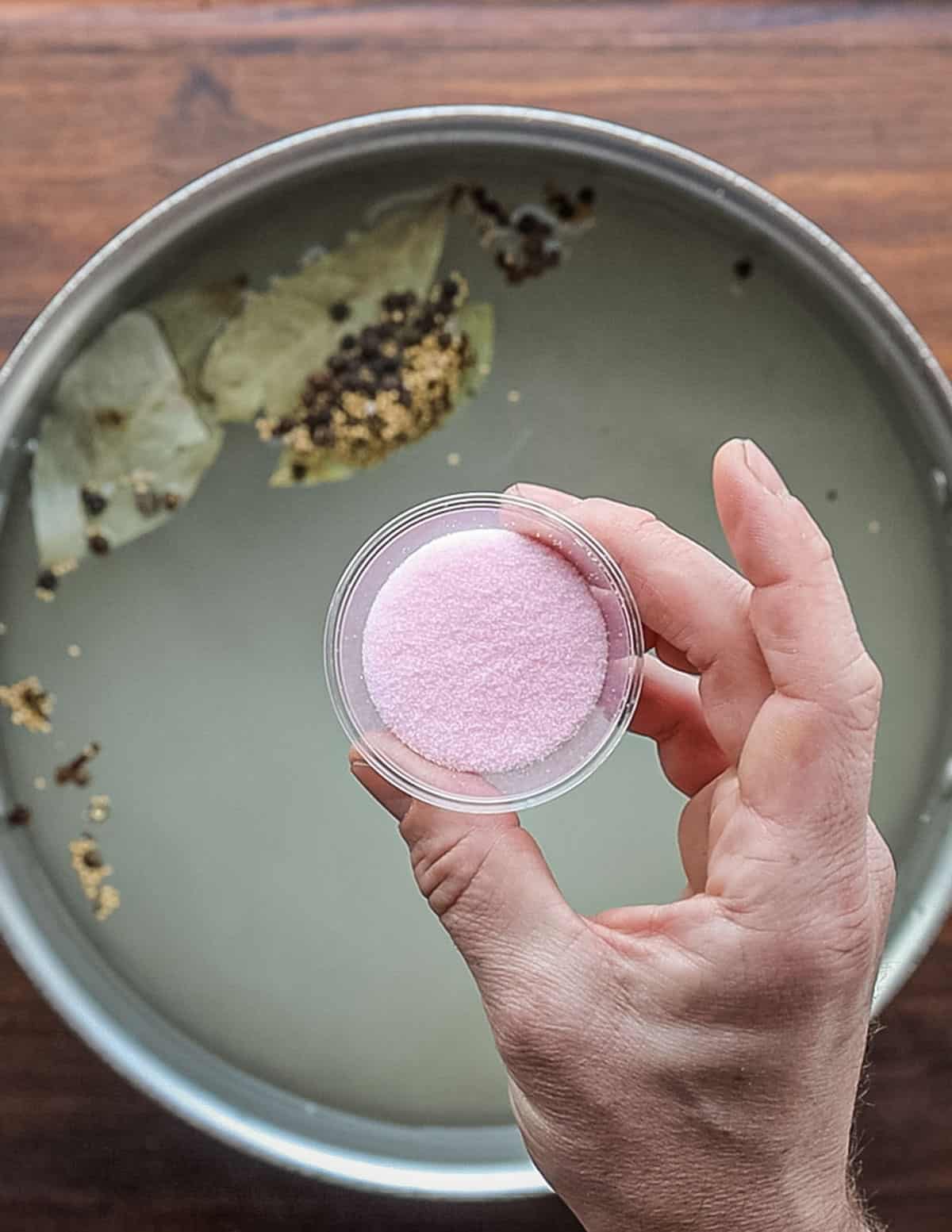
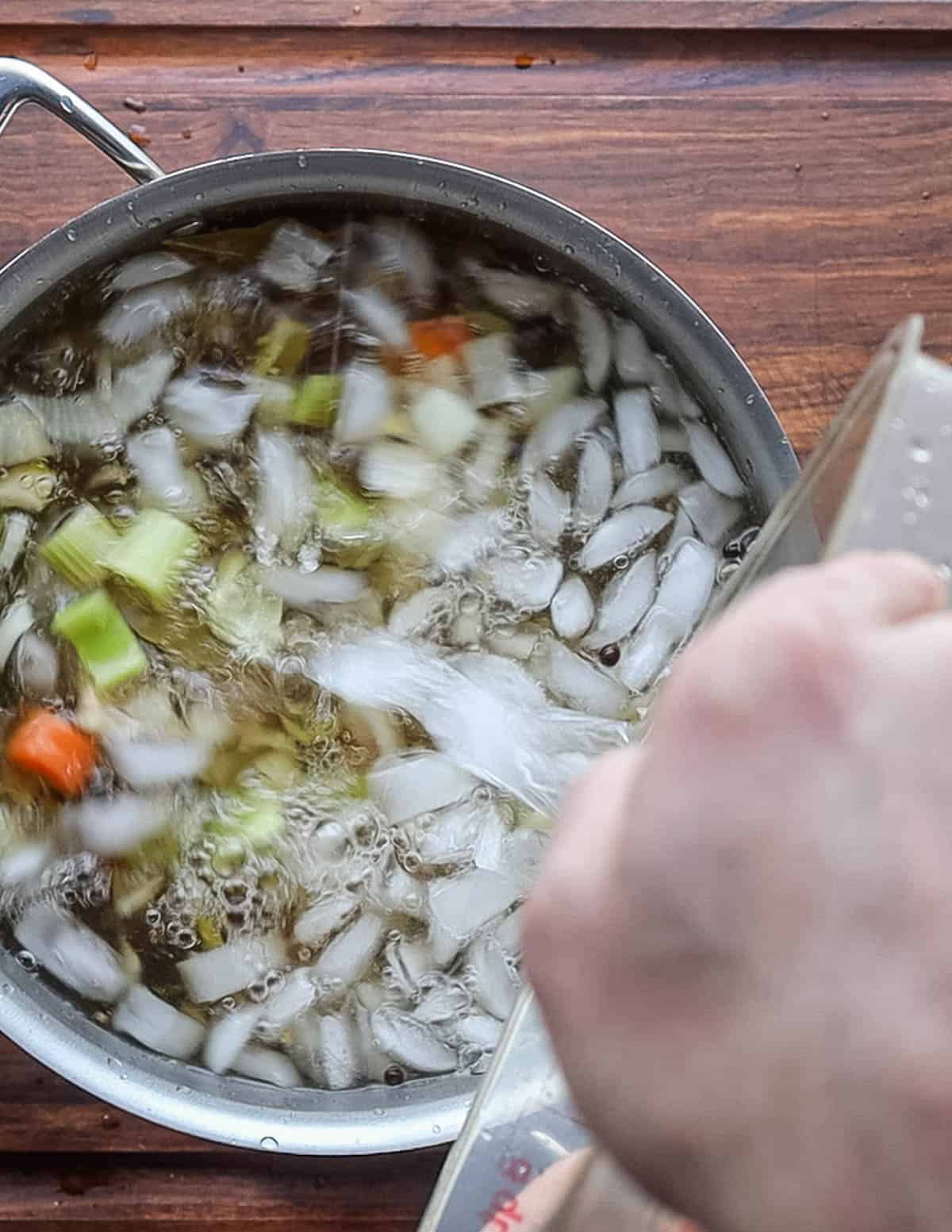
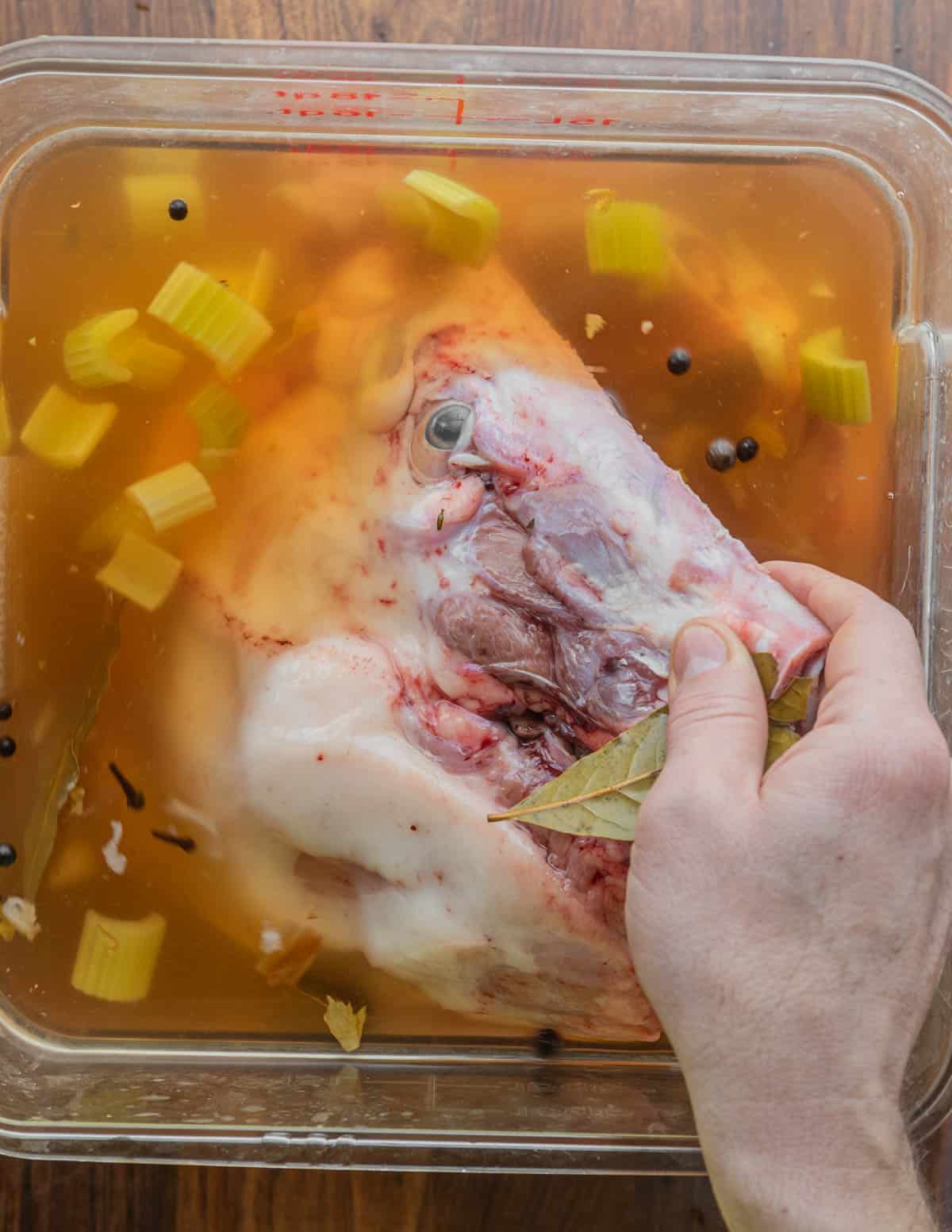
Cooking
After brining, the head is covered with water and vegetables and cook until tender.
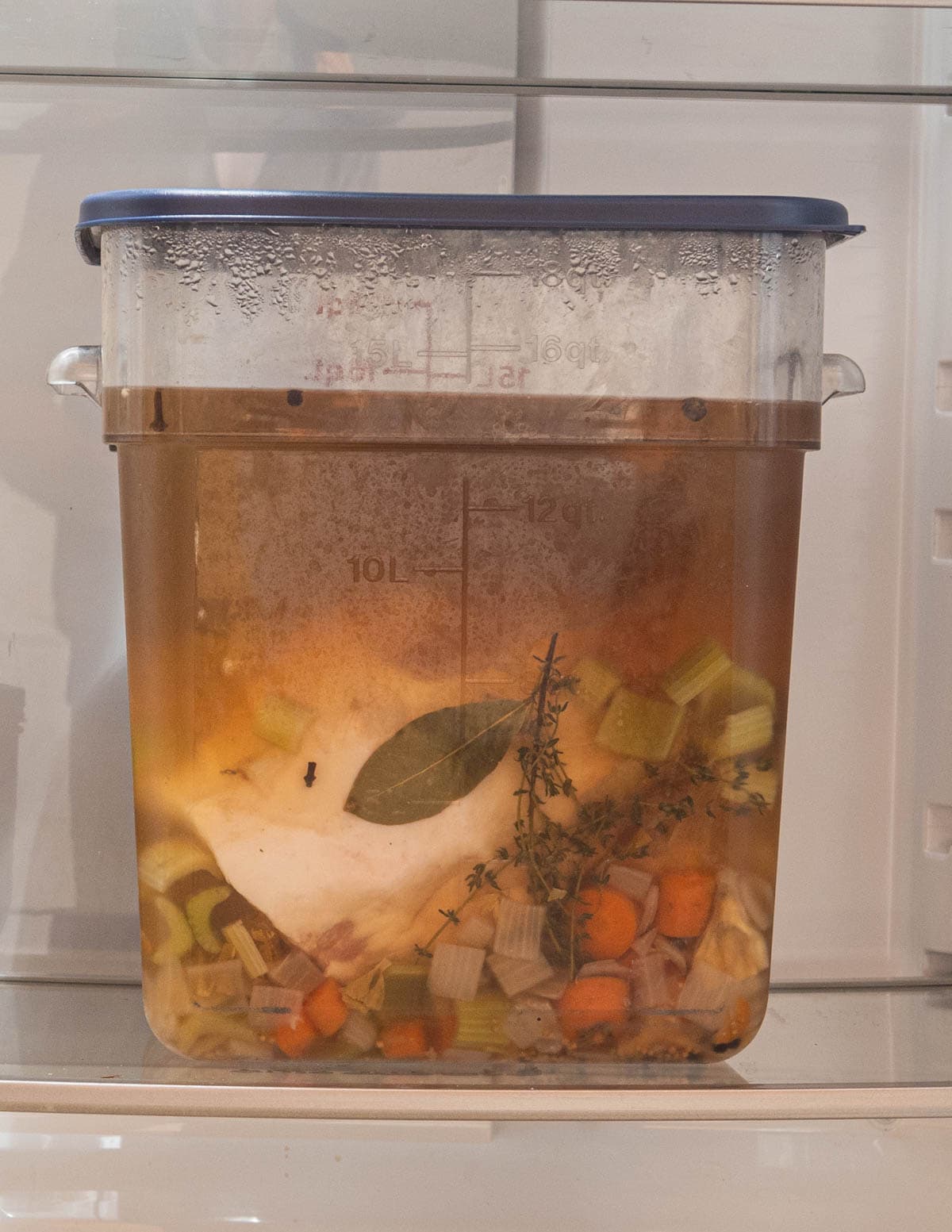
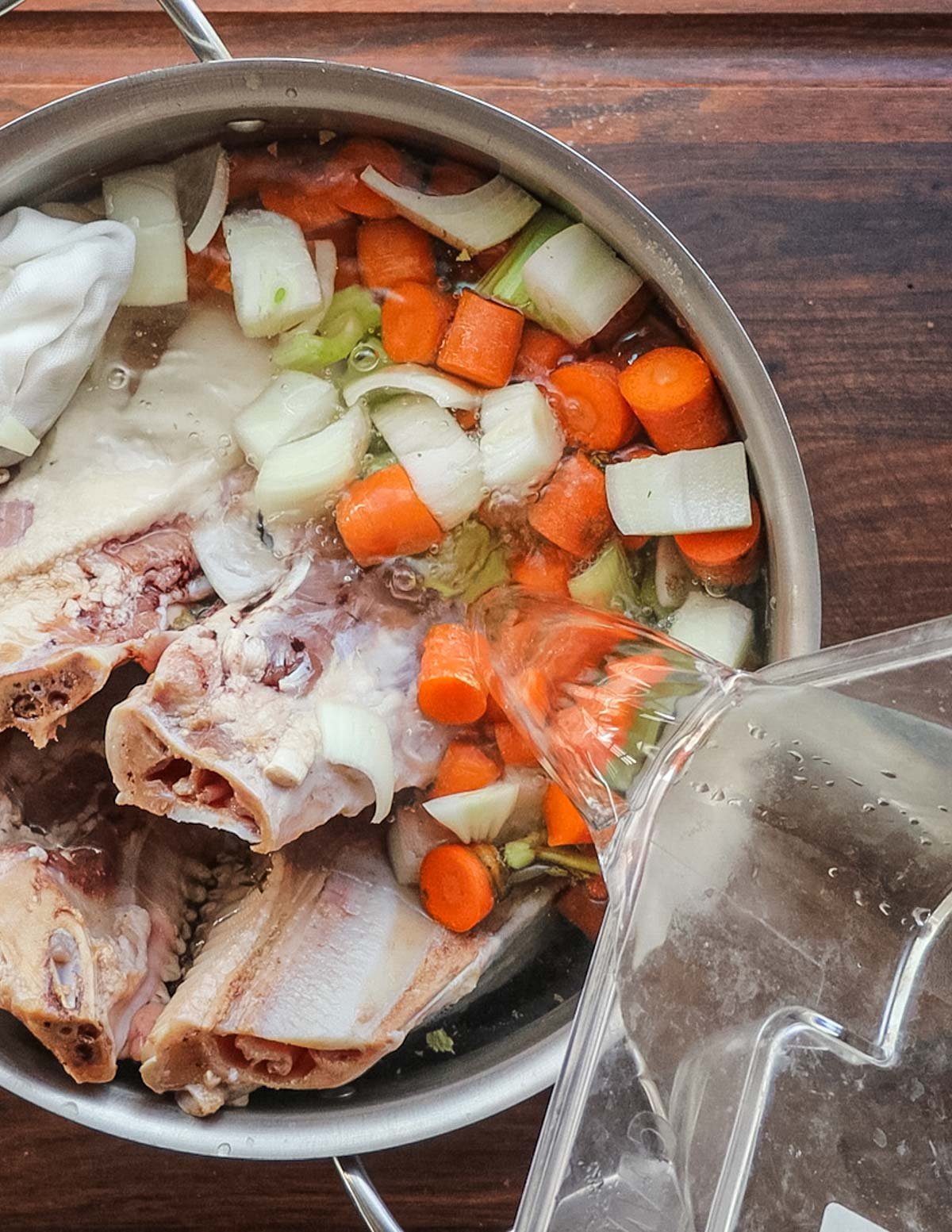
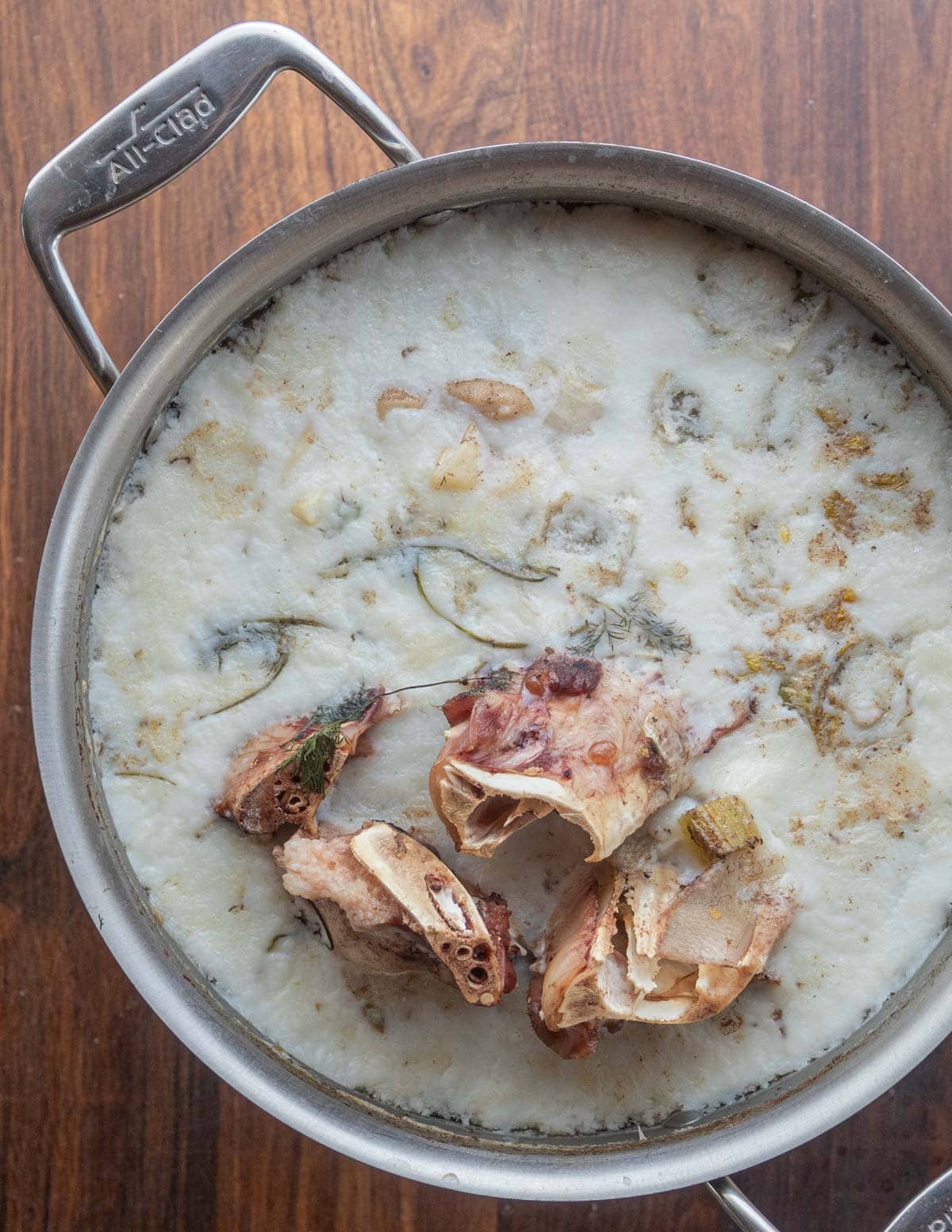
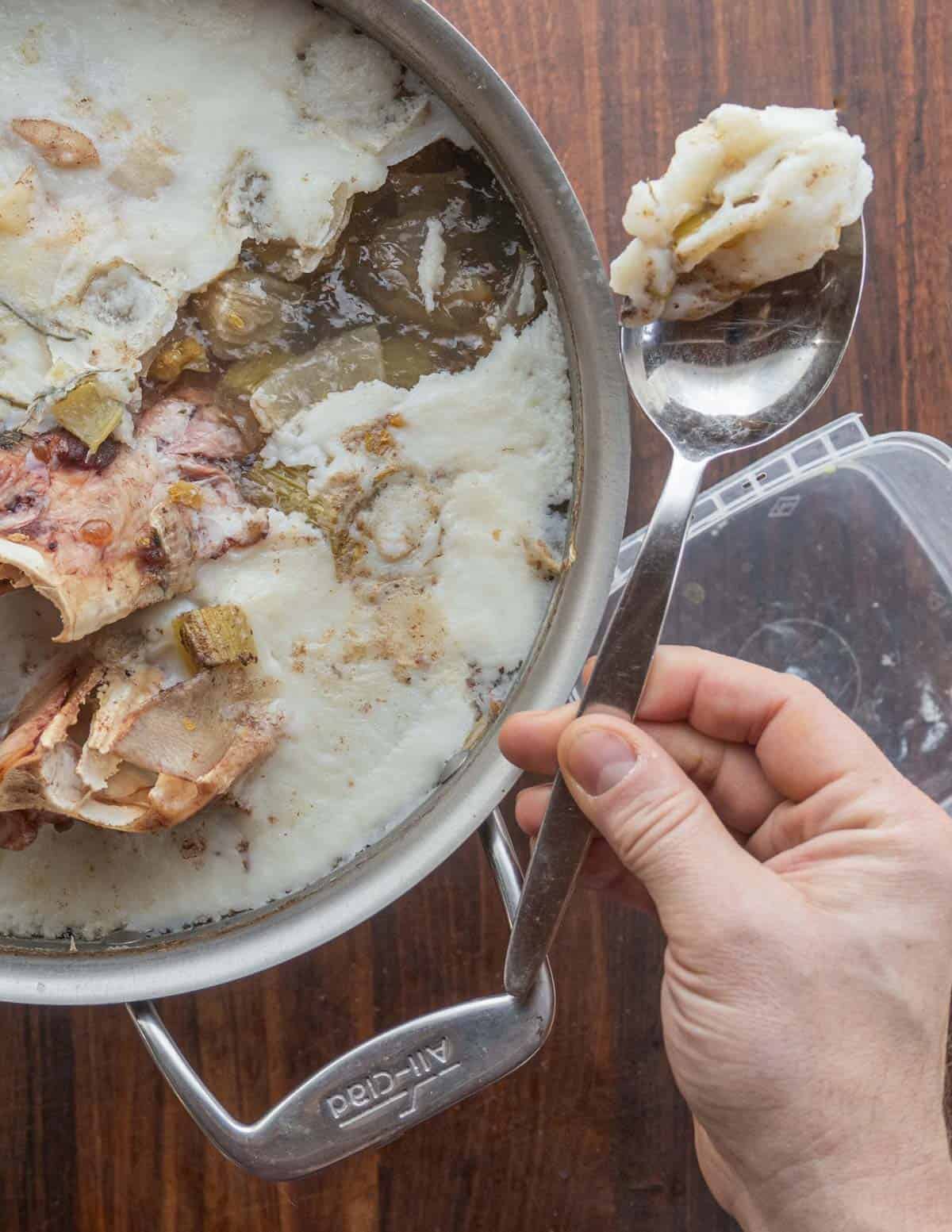
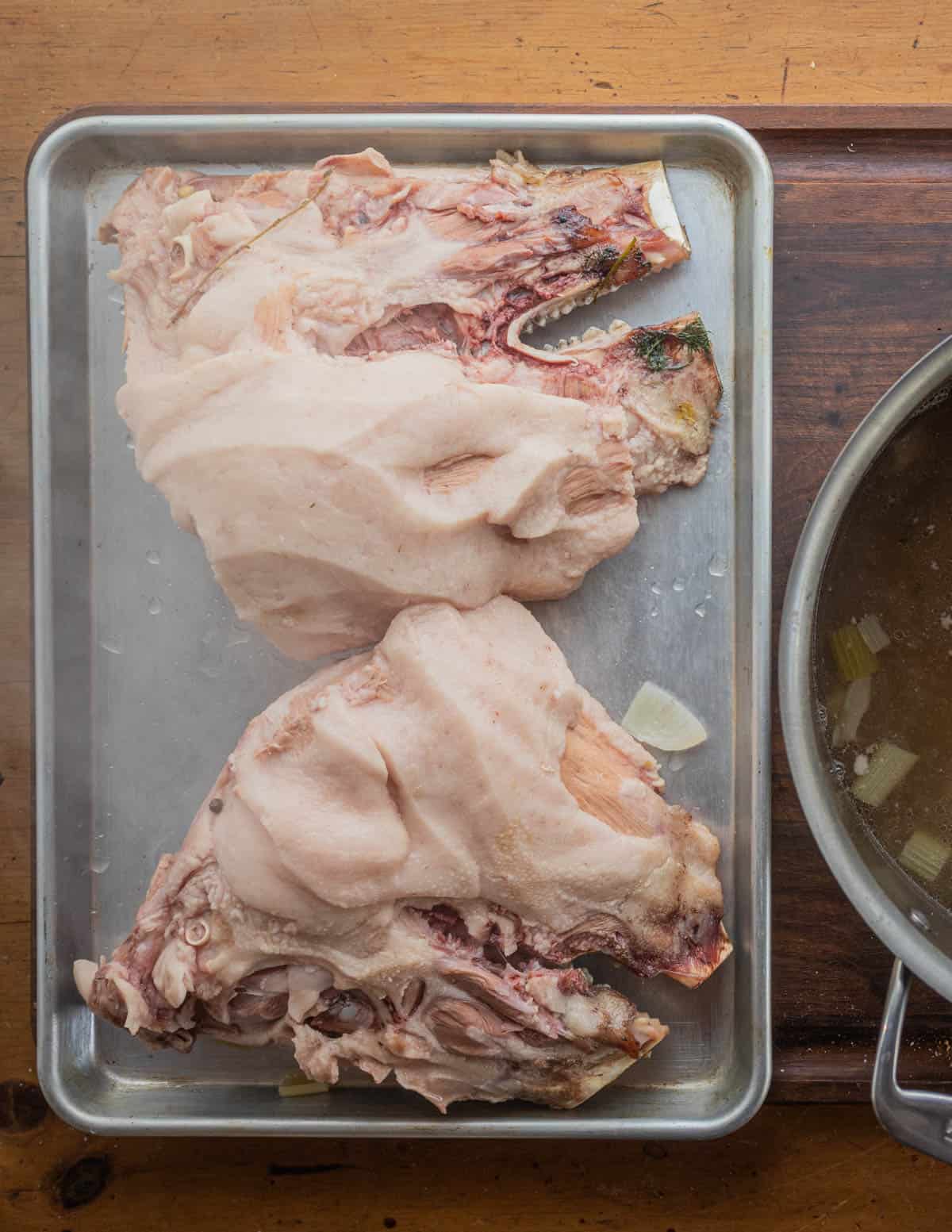
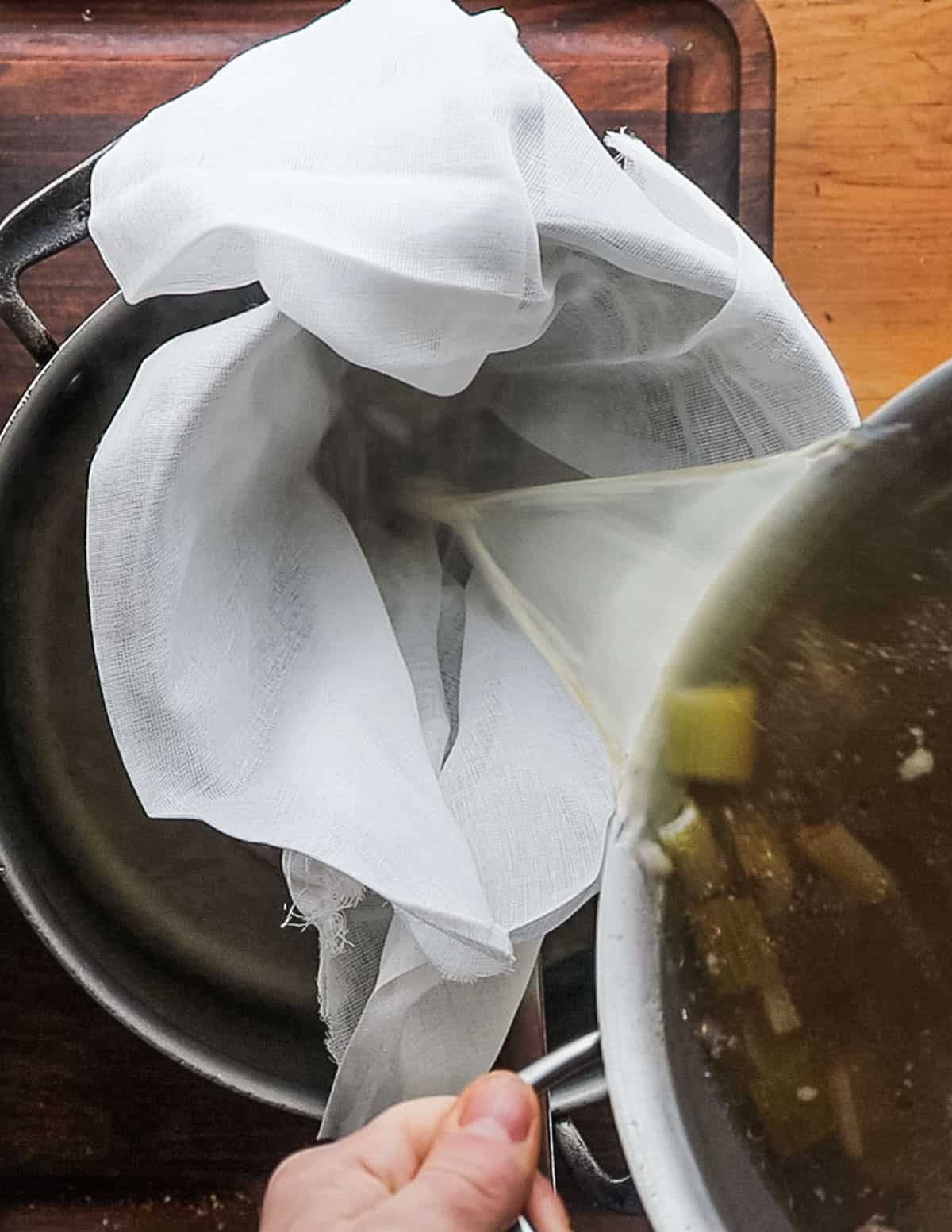
Removing the meat
After cooking the meat is removed from the head. Fat and gristle are discarded.
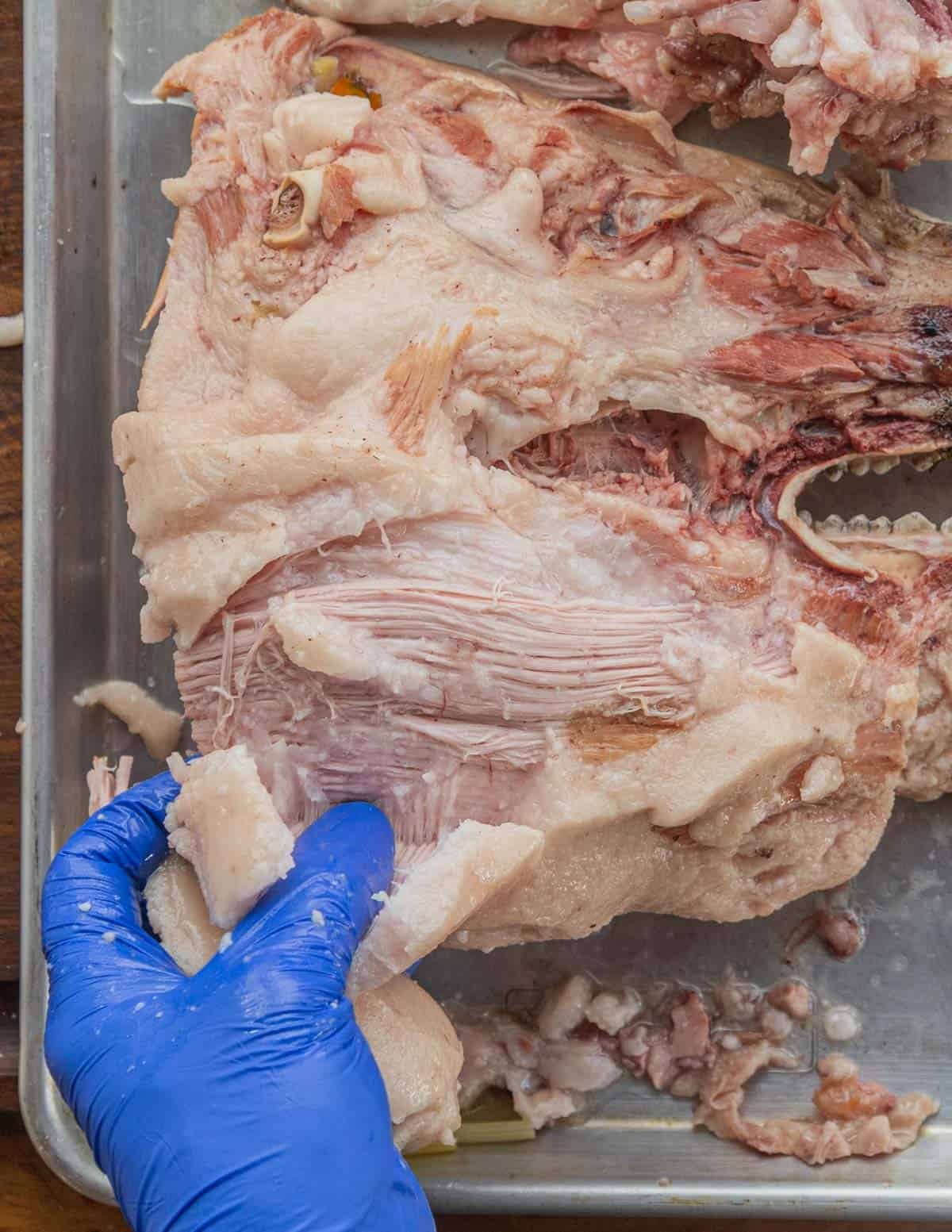

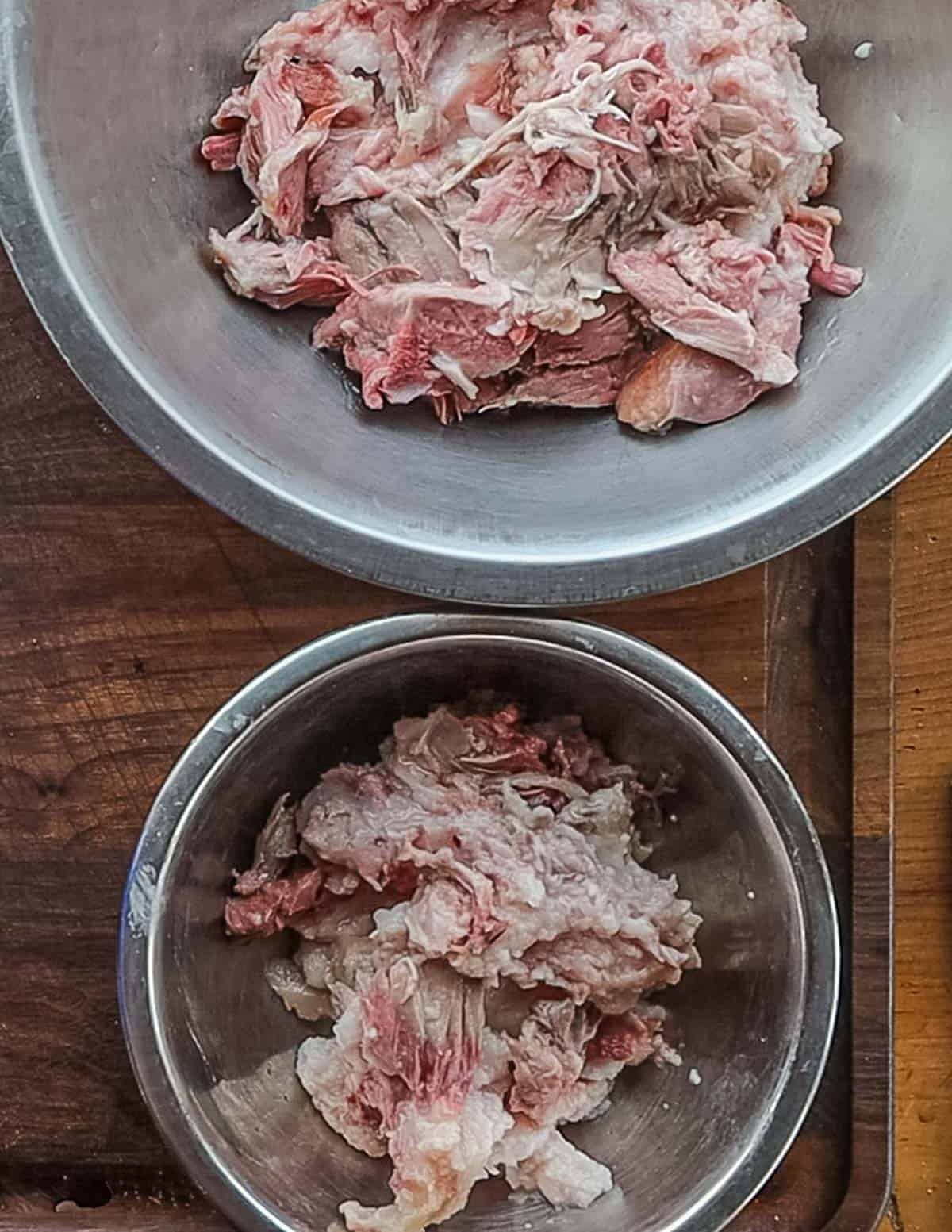
Assembling the headcheese
The cooking liquid is strained and reduced until only 2 cups remain. The meat is cut into rough cubes.
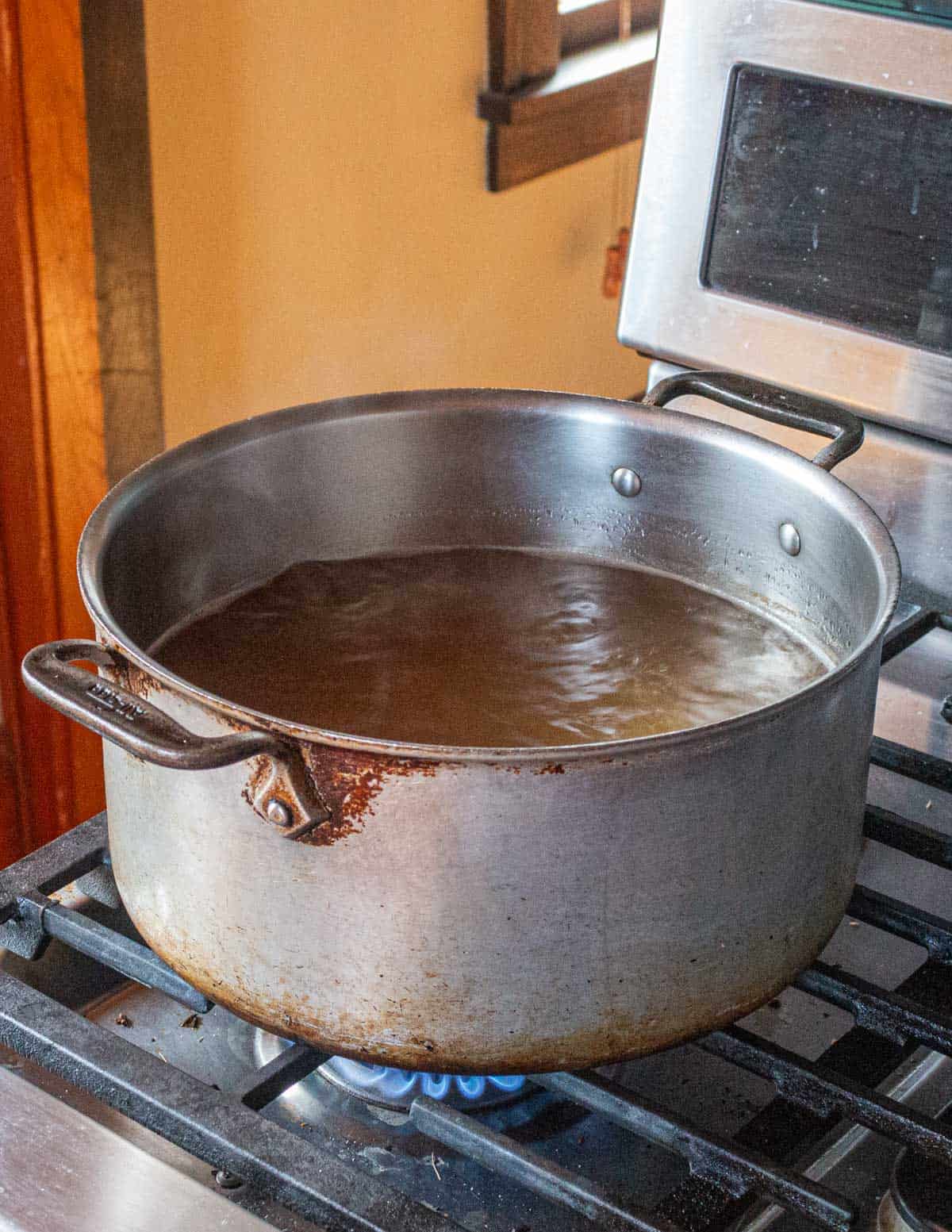
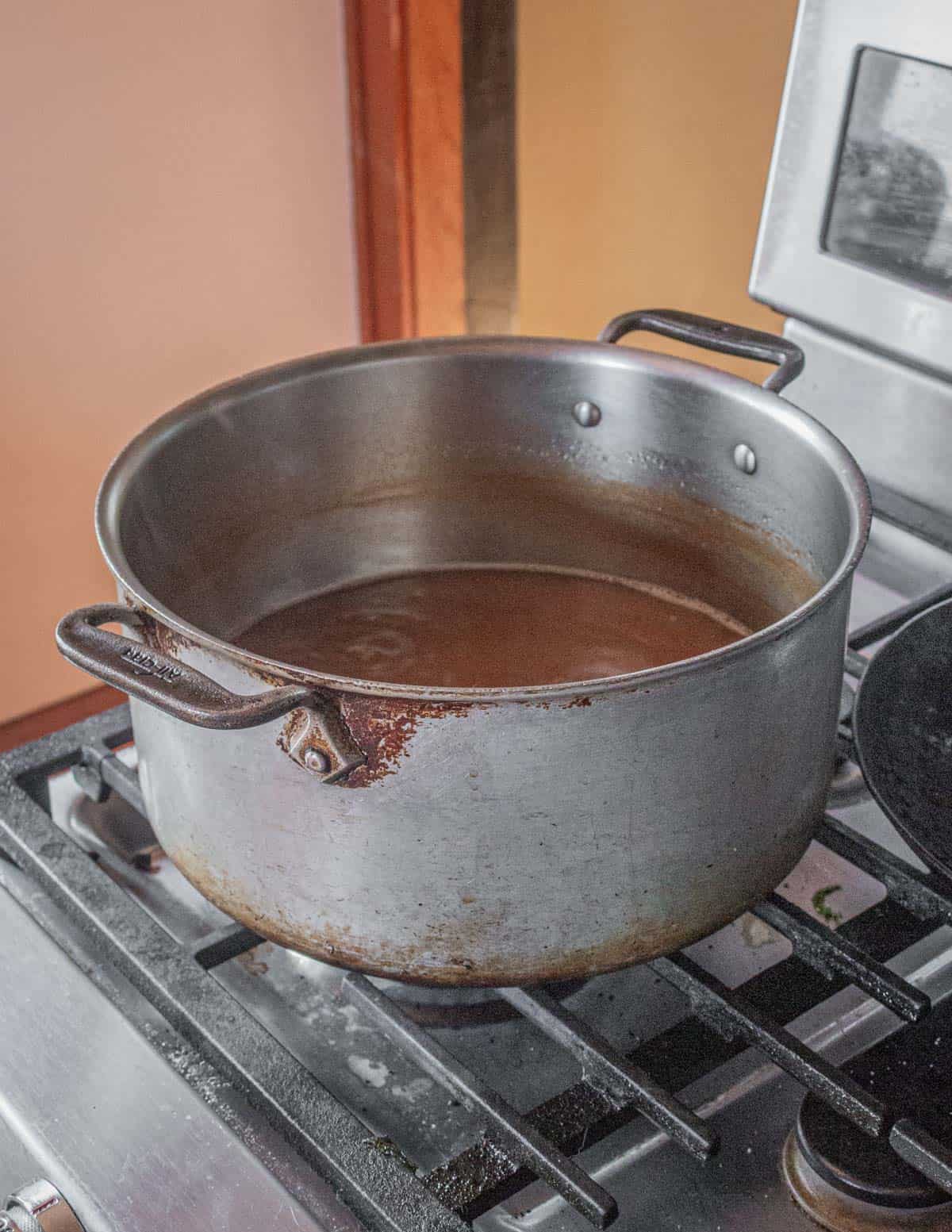
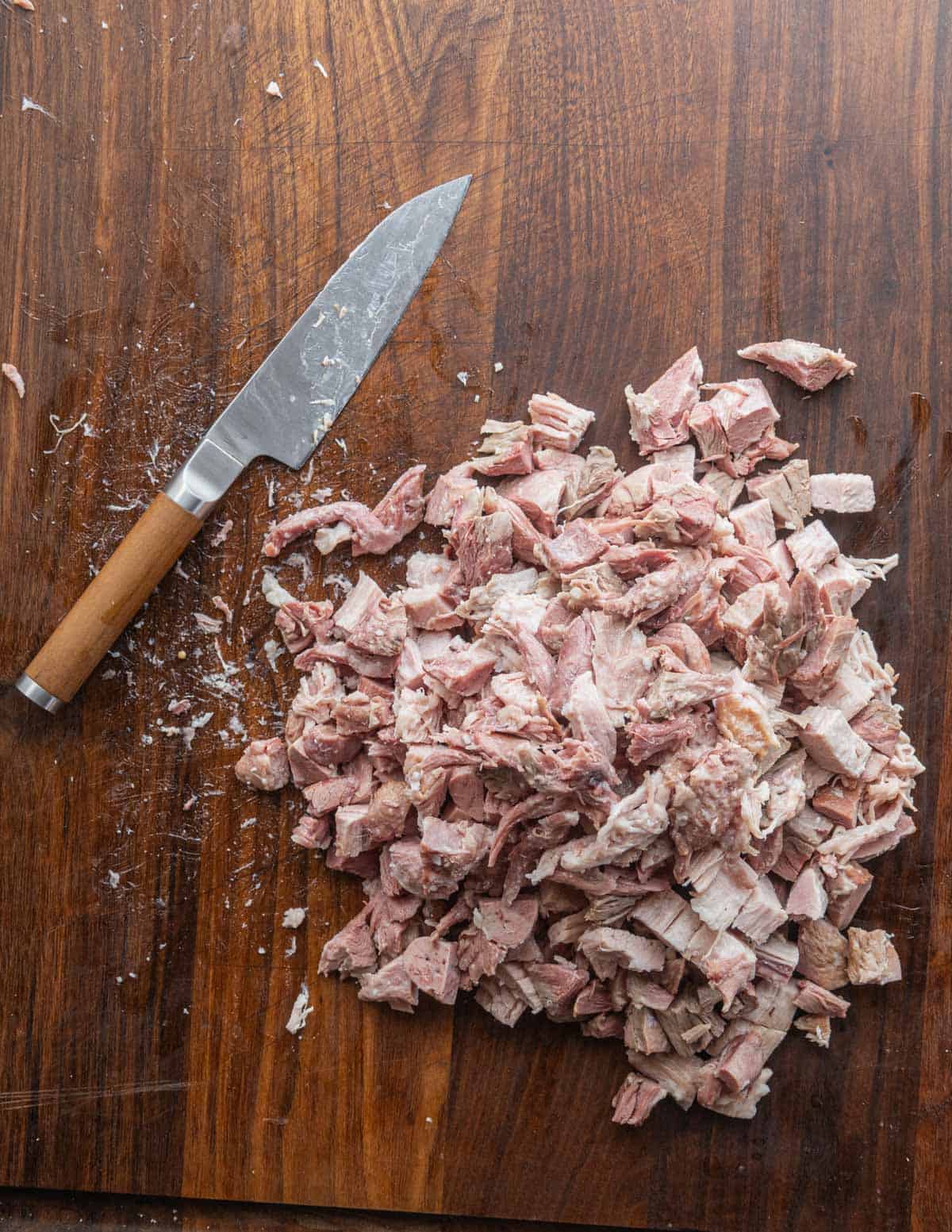
Once the meat is chopped it's mixed with the cooking liquid and packed into a loaf pan.

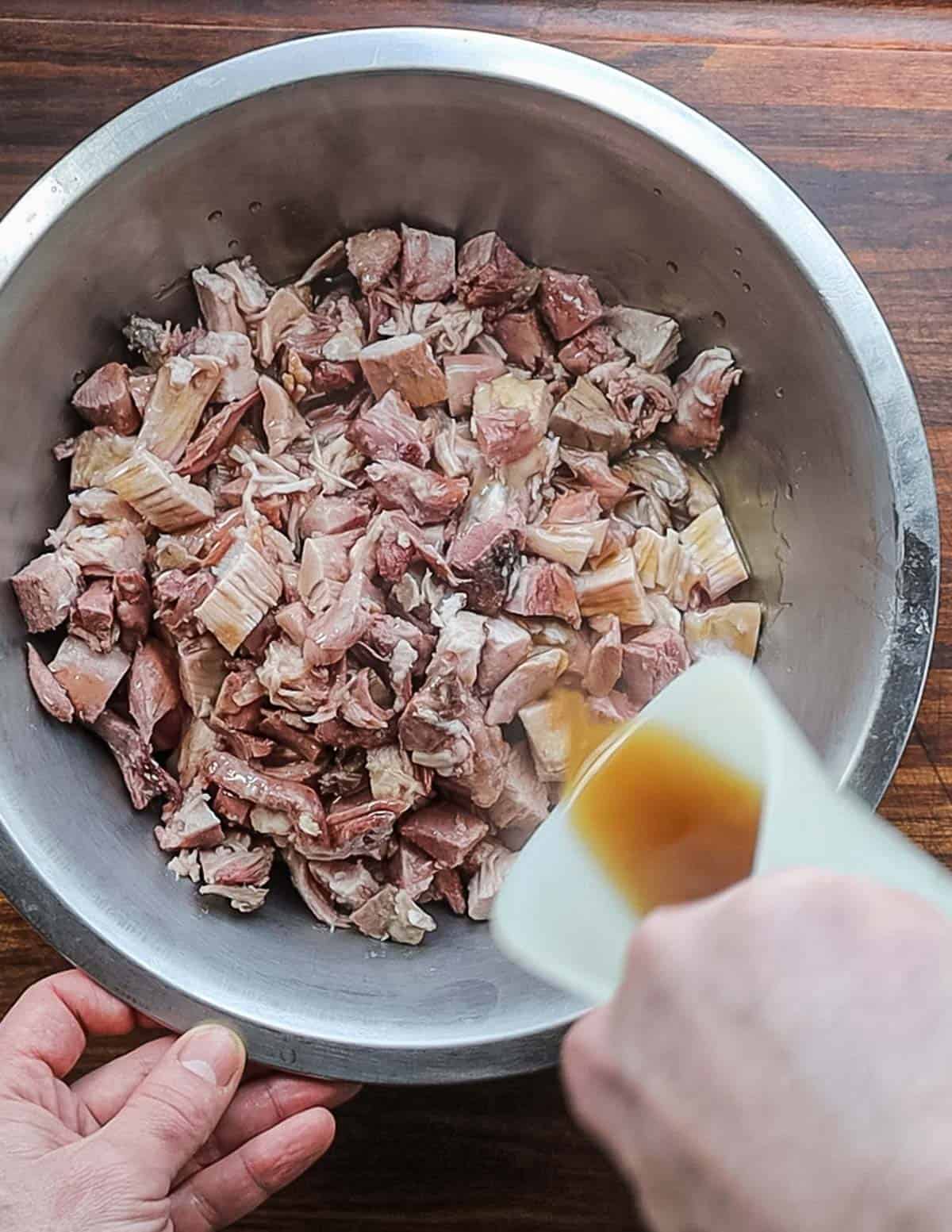
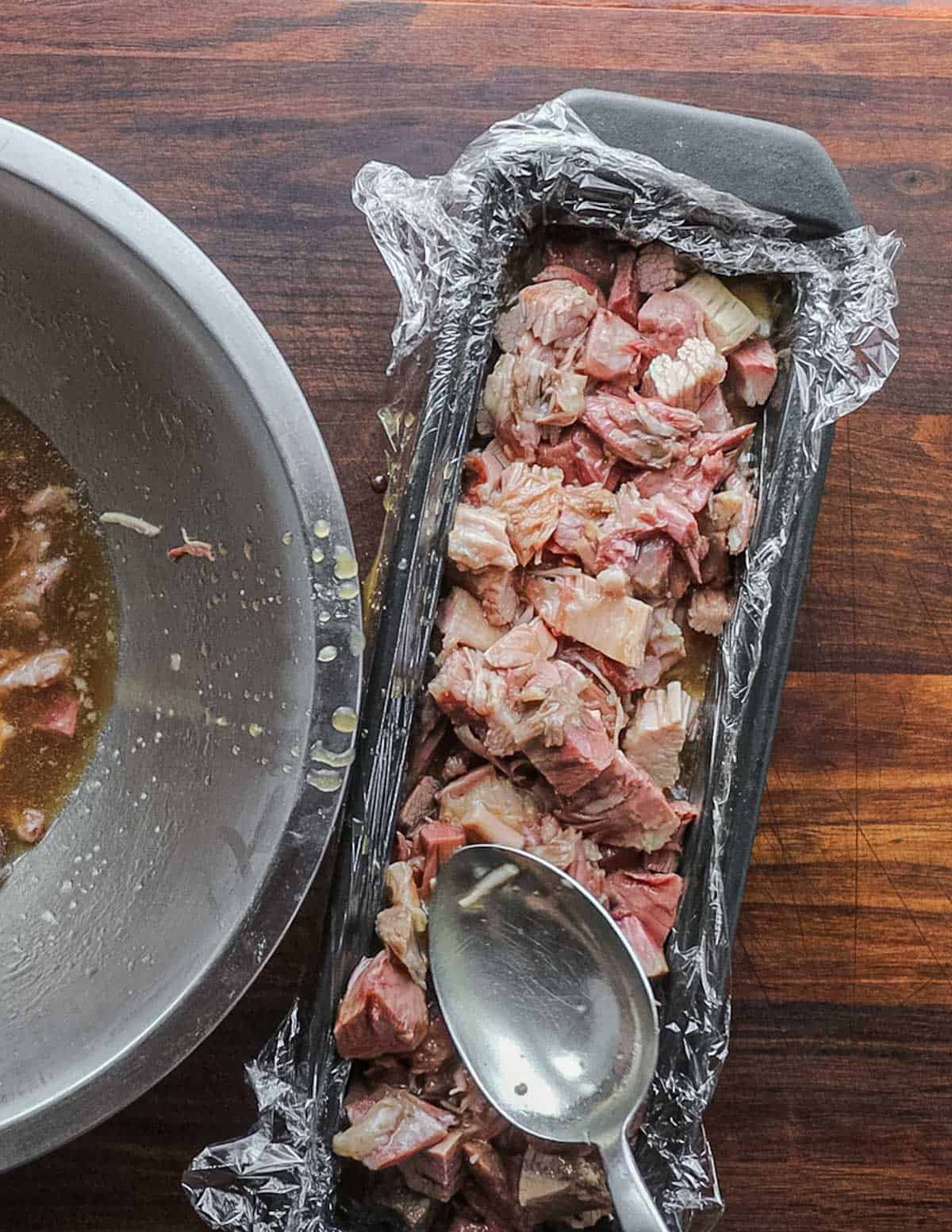
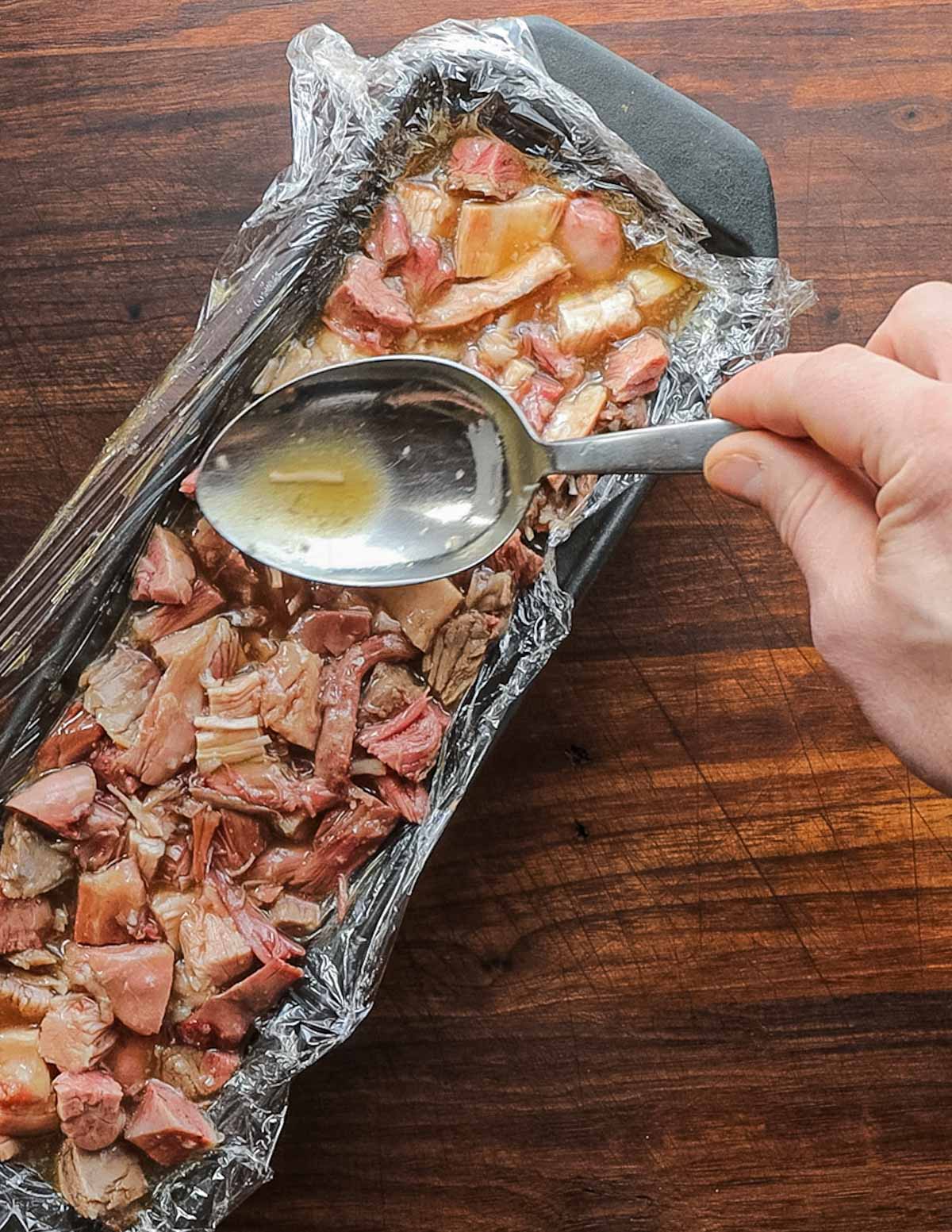
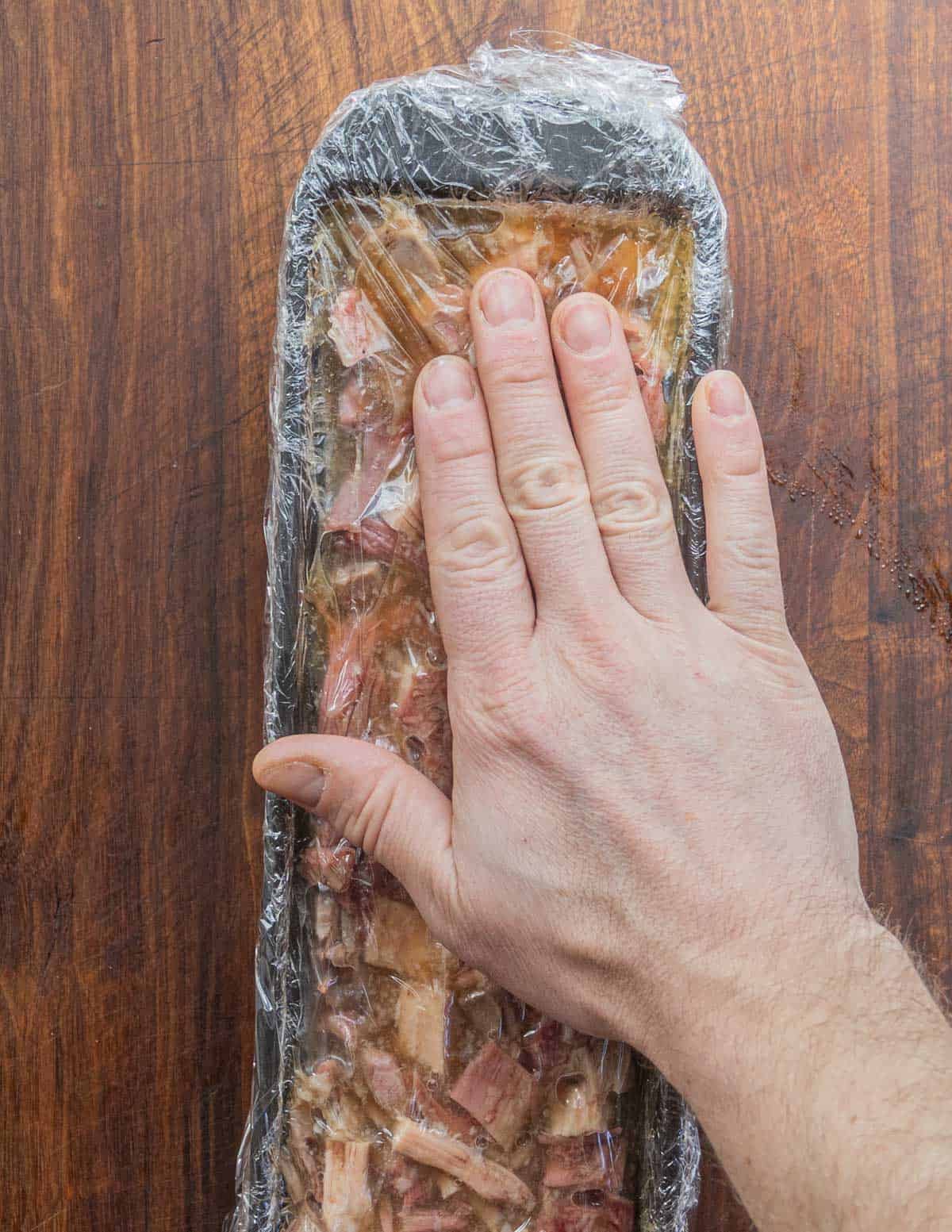
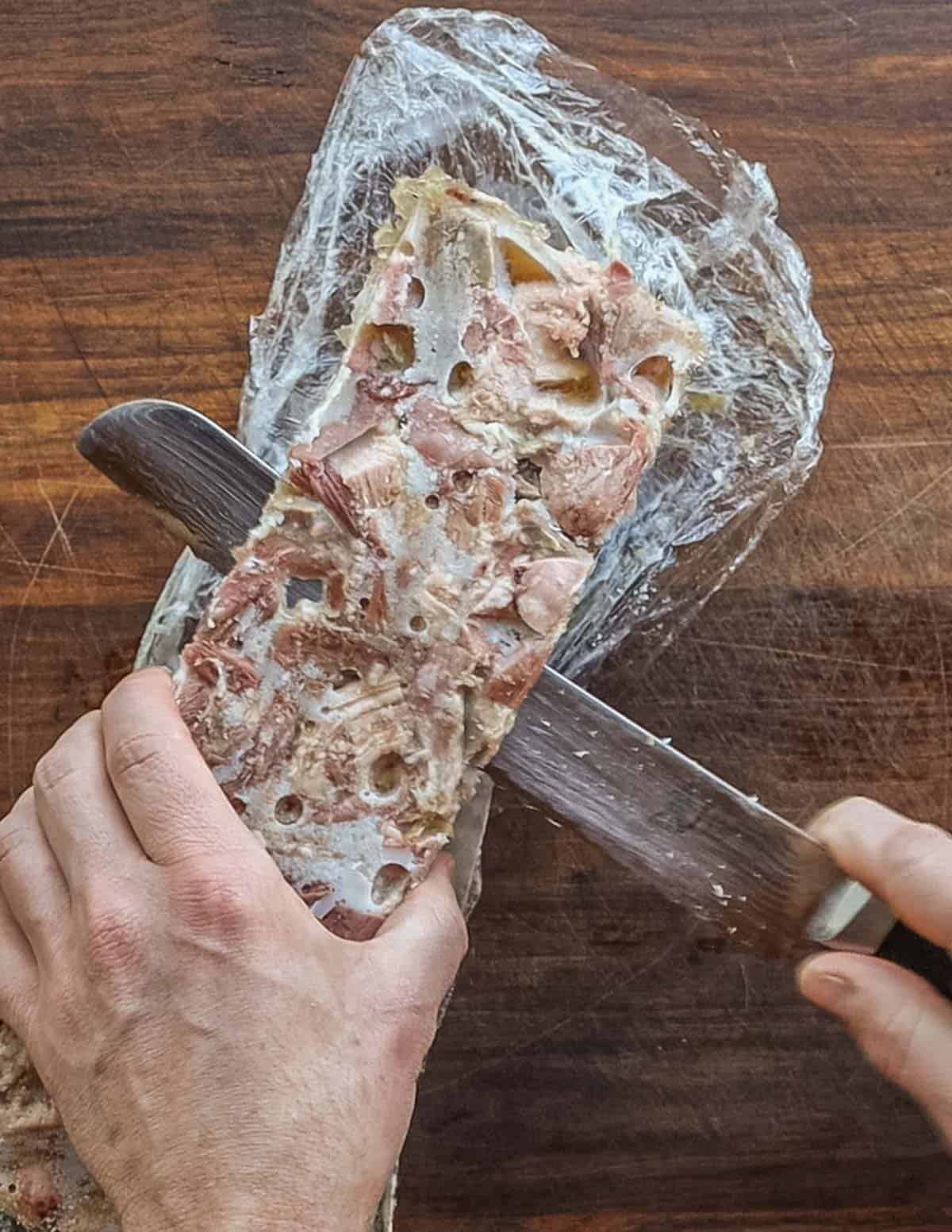
After trimming the finished head cheese can be frozen or refrigerated for a week.
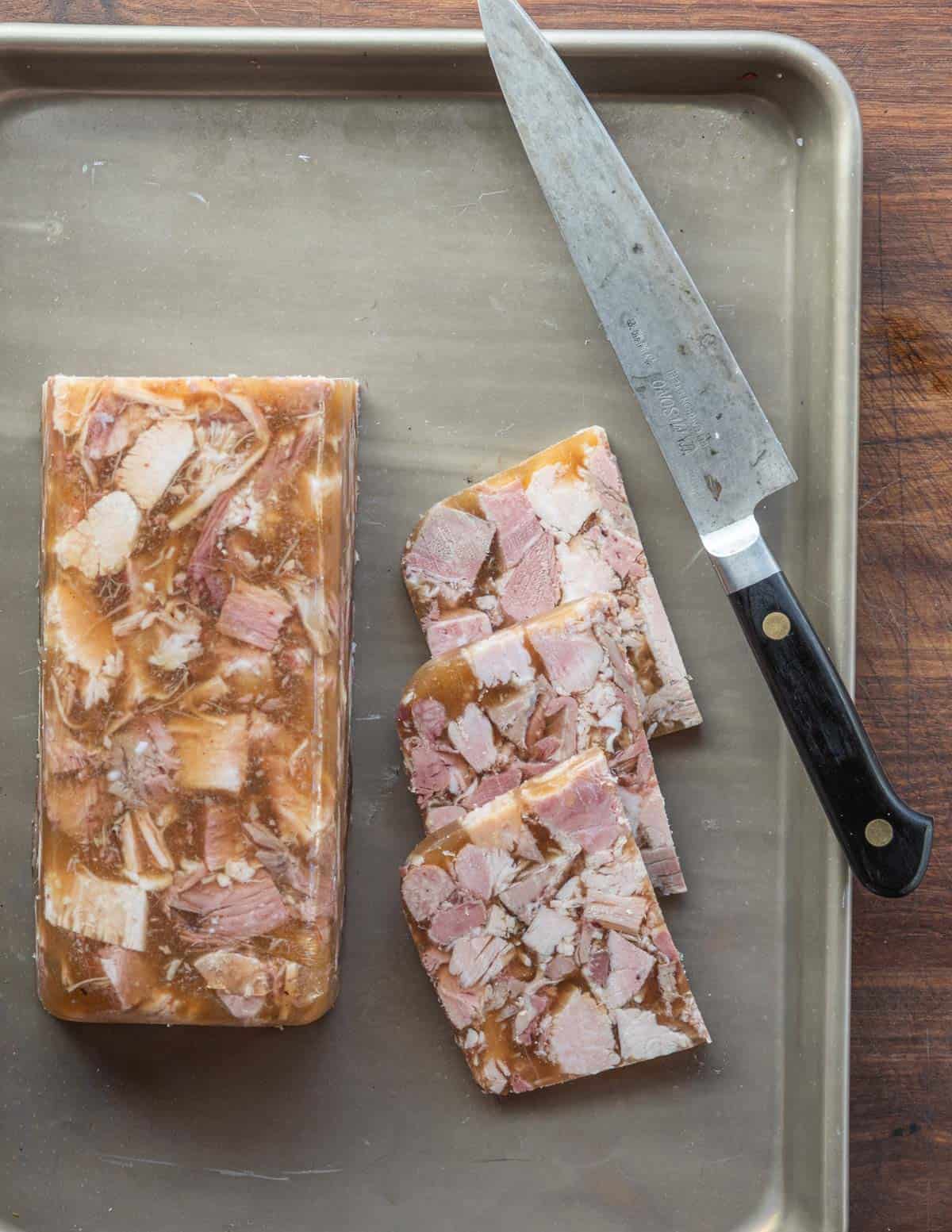
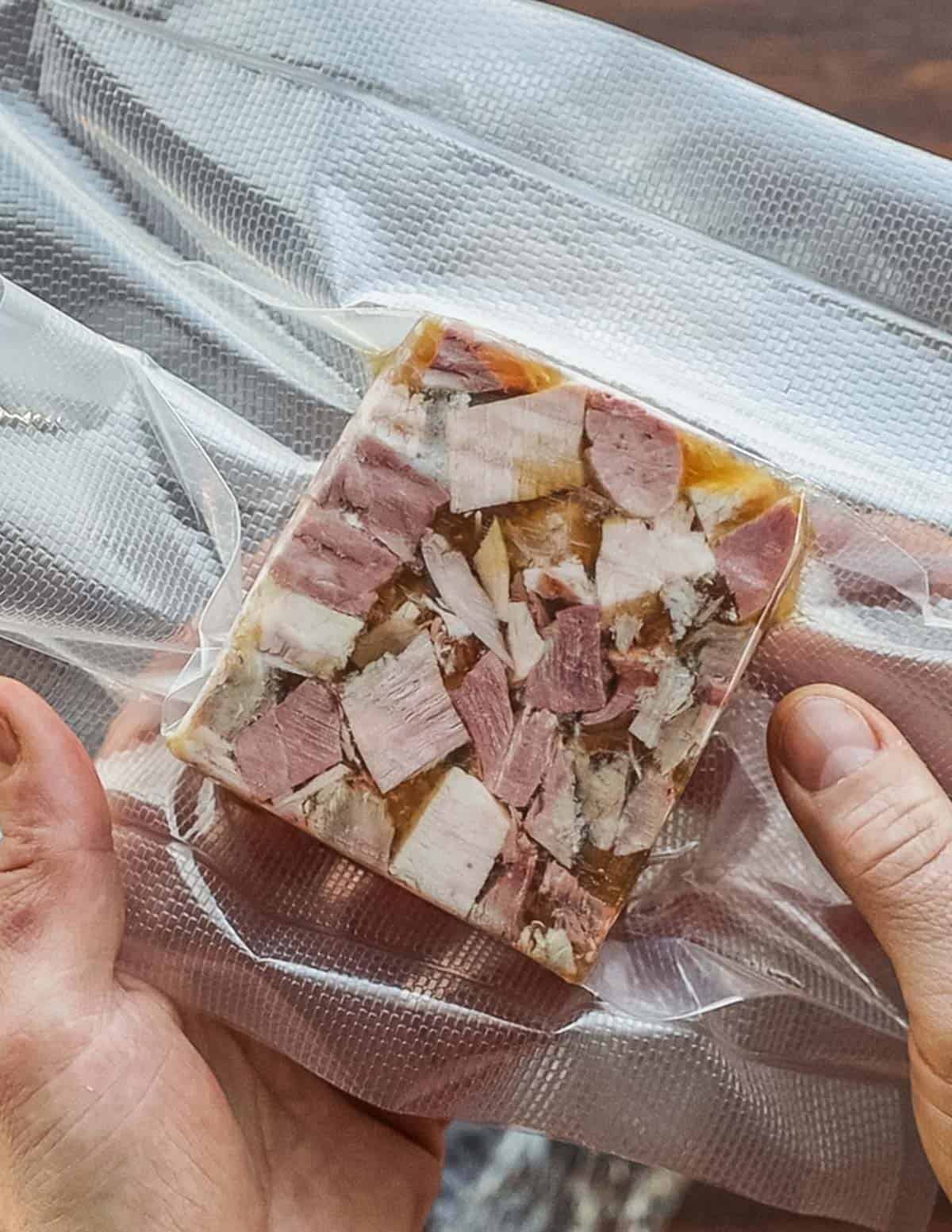
Once you make headcheese you'll be able to create your own aspic terrines. Beef neck or shank terrines are great. I've even made one with venison trotters.
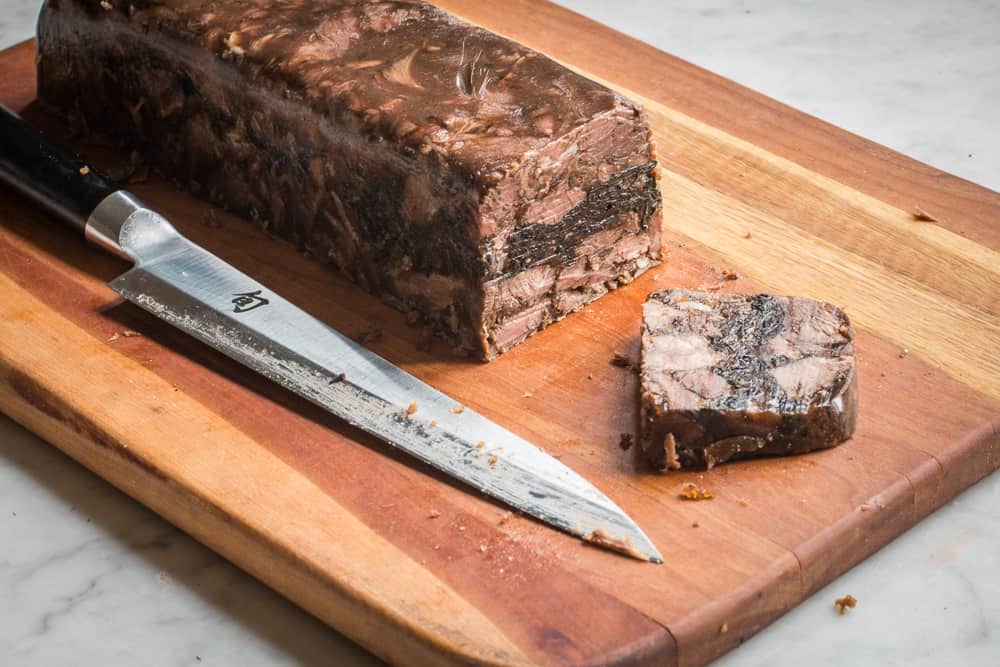
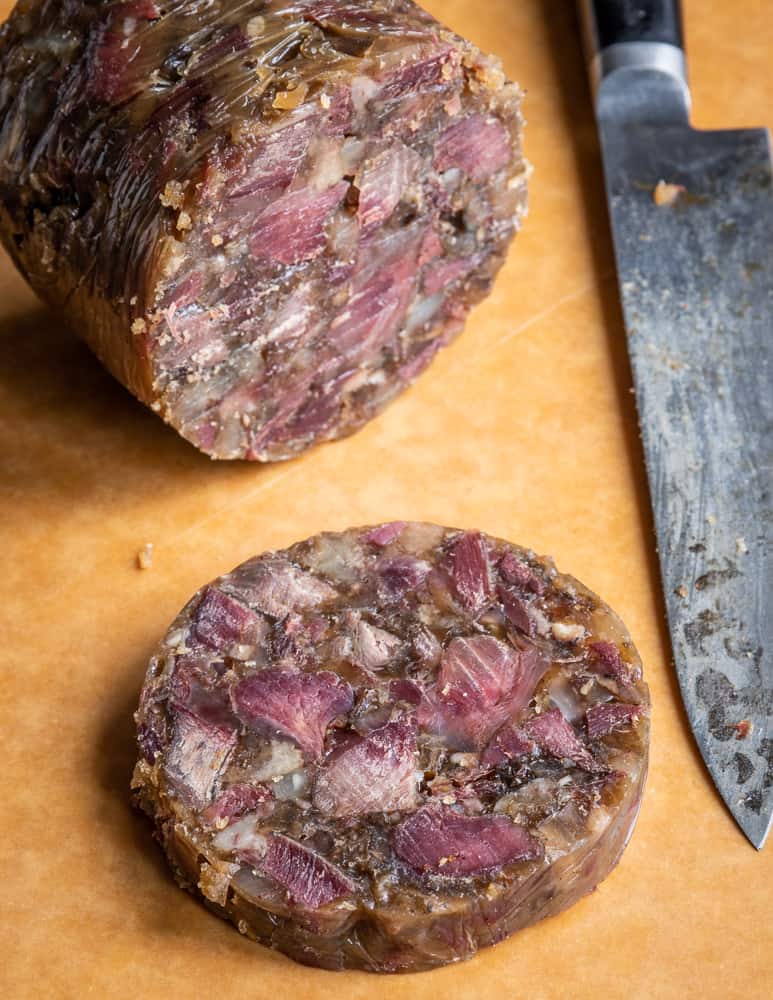
Related Posts
Classic Pork or Hog Headcheese (Fromage de Tete)
Equipment
- 1 large pot
- 1 Large container for refrigerating the head in brine
- 1 Large strainer or sieve
- 1 Loaf pan or large coffee can or another mold
Ingredients
Brine
- 2 gallons water
- 1.75 cups kosher salt
- 1 cup brown sugar
- 4 oz (10tsp) pink salt (prague powder, not Himalayan pink salt)
Head cheese
- 1 pig's head halved, brains removed and saved for another purpose
- 1 pig's tongue optional
- 1 pork trotter, halved (optional) This will give the stock extra gelatin, but is optional.
- 2 cups each chopped carrots, leeks or onion and celery
- 1 garlic bulb halved
- 1 gallon water
- 1 bottle dry white wine (4 cups)
- 1 gallon ice water or cold water
For the bouquet garni
- 10 sprigs of thyme
- 1 bunch of parsley
- 3 fresh bay leaves
- 10 black peppercorns
- 5 cloves
- 1 whole nutmeg
- 5 whole allspice
- 1 tablespoon yellow mustard seed
Instructions
Brine
- Bring the ingredients for the brine to a boil, then add the cold water and allow to cool. Place the halved head, tongue, and trotter if using In a large container and cover with the brine, making sure they're completely covered. If you don't have a large fridge, consider doing this in the winter so you can keep it cold outside--the salt will prevent it from freezing.
- After 24 hours, remove the head from the brine and put into a large stock pot with the bouquet and remaining headcheese ingredients. Bring the mixture to a simmer, then cook covered for 3-4 hours, or until the jaw wiggles easily from the skull.
- Chill the pot overnight and remove the fat (optional). The next day, heat the pot until the head is warmed through.
- Using tongs remove the cooked head slices to a baking sheet.
Tongue
- Peel and diced the tongue into ½ in cubes.
Picking the meat from the head
- Working carefully to avoid bone fragments, remove the meat from the head and discarding connective tissue, skin, fat, bone, cartilage, or anything that doesn't look delicious or feels like it would be awkward in your mouth.
- Chop the meat roughly, mix with the tongue, and reserve in a covered container. Don't miss the ocular meat behind the eyes as it's some of the best.
Reduce the liquid
- While you're picking the meat from the head, strain the braising liquid, then return it to a simmer on the stove in a wide pot. Reduce the liquid by half, then slowly down until 2 cups remains. This will take a while.
- Test the gel of the braising liquid by spooning some onto a frozen plate or a metal bowl over ice. The liquid should gel easily when it cools. If it doesn't, reduce the liquid in ¼ increments, continuing to test until it gels and sets nicely.
- I usually need about 2 cups of liquid for the terrine.
Chill and Form
- Line a terrine mold or bread pan with plastic wrap so that there is enough plastic hanging over the edges to cover the terrine completely when the pan is filled.
- Mix the diced, braised meat with half the reduced cooking liquid and pack into the pan or mold. Pour the reserved braising liquid over the top. Tap the pan on a cutting board or another hard surface to help the liquid distribute throughout the terrine.
- Fold the plastic over the top of the mold. Place the mold on a cookie sheet to catch any drips of gelatinized stock. Refrigerate the headcheese.
Serving and Unmolding
- The next day, un-mold the headcheese remove the plastic, and slice ½ in thick with a long, sharp knife to serve. The headcheese will keep for a week.
Video
Notes
- Add a pork trotter for extra gelatin.
- You can use pork shanks instead of a head.
- Used a smoked pigs head if you have a smoker.
- Lamb or goat heads don't have enough meat to make headcheese.
- It's possible to over-reduce the braising liquid which will give headcheese the texture of a super ball. It should be solid enough to cut with a knife, but not so hard that it's rubbery. It should taste pleasant and melt in your mouth.


Mark
It only works if you're ok with a lot of texture (I am) but fwiw pigs ears, simmered for a long time in whatever seasoning (I basically did a red-cooked style) then sliced and laid in a pan, overlaid with the thickened juice (add gelatin or trotters to the mix) make absolutely stunning terrines--when sliced you see all the ribbons of cross-sectioned pig ears, with the skin taking on whatever cooking liquid color and the ribbon of cartilage inside remaining bright white.... very crunchy and not everyone likes that, but super-pretty.
Alan Bergo
I don’t use the ears in my head cheese-ever. For this exact reason. IMO, (and many years of whole animal butchery focused cuisine in restaurants) ears are best braised low and slow, chilled to firm them, then sliced very thin and crisped up for salads, etc. One notable exception is the literal snout. A butcher from Rome taught me a traditional dish where it’s braised, then the nostrils stuffed with shredded pork. Richest thing I ever ate, and we would garnish it (in comedic chef fashion) with truffles.
Roxy
Hey Alan!
I have a wild boar head I'd like to use to make this. Are there any special considerations I should have? I read that ideally it should be scalded to remove the hair first... Anything else? Thanks as always for your wonderfully detailed recipes for obscure dishes!
Alan Bergo
You'll get a little more meat from scalding vs peeling. Boar will also make a much smaller version, from what I know.
Ruth
I have two Prague powders. You do not specify #1 or #2 in your recipe, but they are not the same thing, and not used for the same purposes. Yes, they are both pink salt, but I'd appreciate knowing if your recipe calls for #1 or #2, as I don't wish to make a mistake. Thank you
Alan Bergo
Instacure no2 is used to make fermented salami and raw, dried meats. It’s never used for meats that are cooked. Instacure no1 is used for ham and brined meats like head cheese. I’ll take a look at the recipe and make sure that’s clear.
Gavin Baker
Hi chef. Quick question re: pink salt weight. You listed 4 oz / 10 tsp of pink salt, but @ 6g p/tsp, 10 tsp is roughly 60g, which is approx 2 oz. Ruhlman does the same thing in "Charcuterie". Curious if this is meant to be 20 tsp? Much of the online info is geared towards long-brined items like pastrami, which seems to have a much different ratio of pink salt than the overnight brine used for pig's heads.
I'd already added the pink salt to my brine before realizing that it looked to be much more than 10 tsp, so I'm running with the true 4 oz for this head (I have 15 heads total), which is closer to 24 tsp (2 gal total, 12 tsp p/ gal). From what I can find, however, the ppm for 12 tsp p/ gal is way above the "safe level". Many people seem to default to either 1 tsp of prague p/ 5# of meat, or 1 Tbsp p/ gal - both of which are much less than I'm using. But perhaps this is because these are for the 5-12 day cures and the prague has more time to penetrate the meat?
Thanks in advance for any light you can shed on this.
Alan Bergo
Hi Gavin. This recipe was passed onto me from my old Chef Lenny Russo, and is the carbon copy of the recipe he served in the restaurant for over a decade. With pink salt, I used to follow Rhulman and Polcyn's proportions like the Bible, but I've found you can often get away with less, and I've knocked 30% or so off of most recipes without issue. Brines and liquids always have what seems like a bunch of pink salt, but the vast majority of it is discarded. You can probably get away just fine with the proportions you're suggesting if you want, do what you're comfortable with.
Gavin Baker
Thanks so much chef! Dropping it down by 30% makes me feel more comfortable as well so I will try that on the next batch. Then I can compare the two batches side by side and go from there. By the time I get through all 15 heads I'll be a lot more comfortable with the pink salt overall.
Frank Wilk
If I forgot the curing salt in the brine can I add it safely to the 3-4 hour covered simmer?
Alan Bergo
No it needs time to penetrate the meat. Take some of the brine out, dissolve the curing salt in it, then put it back with the head in brine. Wait again for the same curing duration in the recipe, then cook per usual. You can soak it in fresh water overnight if you’re worried about it being too salty, but it should be fine. I’m here if you have more questions.
Jacob
My grandmother used to make this and I was looking for a way to do it. I'm not a great cook but the instructions were easy enough to follow, my wife and daughter helped, and it turned out even better than I remember! Gram would be proud. We used the head of a Swabian pig we raised.
Gerry
My grandfather would make this on the farm and I've been looking for a way to recreate it. This is far and away the most comprehensive article blog on the whole internet, as far as I've seen!! I wish people kept the tongues in the heads though, but I understand why the producers remove them.
john
In my day on the farm we boiled the whole head over a open fire in a big cast iron pot till the meat fell off the skill then we would take everything out and put it on a sided chopping board, cop the dickins out of it add seasonings, and jelltin mix it all up and put a cheese cloth over it and let it harden
Annette
The Prague powder contains sodium nitrite. Can we just use a regular pickling salt instead? Have you ever tried this, and what kind of results did you get?
Alan Bergo
Hi Annette. Sorry if this seems like pontification but there's a little to unpack here. *ALL* cured meat contains Prague powder: hot dogs, pastrami your Easter ham, most lunch meat, bologna, bacon, etc. Essentially any meat that stays pink after cooking past 150 F has been cured with it. Even cured meat that says it doesn't contain it still does, since uncured meat is actually cured with a naturally occurring version of the compound found in celery and other carrot family plants. Look at the ingredients in "nitrite-free" bacon and you'll see either celery juice, or celery powder. I have a helpful infographic in my post on beef bacon that I made to pull back the curtain for people. Long story short, you cannot substitute pickling salt for Prague powder, and if you do it will ruin the headcheese. The amount you consume is teeny tiny in homemade products compared to commercial products, and you can dial it down a little if you want, although most of the brine is discarded. Prague powder not only preserves the meat, it also gives it a particular flavor. If you like grey corned beef, you might like headcheese prepared that way, but the chef that taught me to make it would roll over in his grave if I recommended someone make headcheese without it.
Ilyssa
Can I use feta brine to brine the head or will the minerals, cheese fats, and lactose, and possibly lactic bacteria interfere with the meat cure?
Alan Bergo
No do not do that. Cheese brine is drastically different.
Ilyssa
Thanks. I’m glad I asked! At what point do I chill everything? Does leaving the nutmeg whole really impart its flavor? (We just started the brine for five heads.)
Alan Bergo
You can crack the nutmeg or skip it. Chill the loaf pan with the meat after you've added the liquid, I made sure it reads correctly in the recipe. I'll be keeping an eye out for your email in the comment section here, don't hesitate if you have any other questions.
Ilyssa
After picking the meat, but before molding, should I season? If so, what are your favorite options?
Alan Bergo
The liquid will be seasoned already from reducing the brine as the meat absorbs the salt. It should be right on. You can also mix the meat with the liquid and then pack it into the mold, that will let you taste it and know for sure. I should probably change that in the recipe.
Lois Luckovich
Thanks for the recipe. My late Dad always did things by memory and never wrote anything down so I've been stymied until now
Alan Bergo
Thanks Lois. I’ll get around to the video here in a couple months. Can’t wait to make it again.
Burton P Johnson
I have access to pig head and I can't wait to make this. Does the pig head need to be skinned before the brine and braise?
Thanks! Burt in NC
Alan Bergo
Hey Burt, this recipe is an undertaking, but once you make it once you'll be able to make it with your eyes closed and you'll understand how it can be made with many different cuts of meat-not just head. Gelatin and aspic terrines are the easiest of all terrines to make, and the most forgiving since they can be re-melted if they don't set properly. As for skinning, no, ideally the head has been scalded to remove the hair, but has the skin on it-this is important as skin contains tons of collagen that will help you get a great, firm set on the finished product. I need to make a video of this, come to think of it. If you have any questions during the process please reach out-answering questions is part of my job.
Duke
Thanks for posting this. Quick question why is the pink salt listed in oz AND tsp? Is it 4 oz dry weight plus 10 tsp volume? "4 oz 10tsp pink salt"
Alan Bergo
Hey Duke, happy to clarify that. So, when you see two different units of measurement for the same ingredient, it's meant to clarify the amount for people that may prefer weight over volume (cups vs oz) or vice versa. With somethings this isn't an issue, but with pink salt especially, I add it both to make it approachable to people who don't have a kitchen scale, and for safety, since you want to use the exact amount called for in a recipe and not more. I added some parenthesis so that is more clear. Sometimes the interface on the site removes certain formatting from Word. Hope that helps, and let me know if you have any other questions. Headcheese is one of the greatest charcuterie methods to learn.
Aimee
Just bought a head to attempt to make this old family favorite. Question...do you boil the whole thing? Eyes, skin and all? What to you discard before brining, and cooking?
Alan Bergo
Yes, you simmer the whole head. Read the recipe carefully. You will be discarding all skin, bones, cartilage, eye balls, etc.
Aimee
Thank you! I read another recipe where they left the eyeballs in.. I discarded that one and went with yours instead because I liked the sound of all your ingredients...plus, your a chef 😊 head is now ready to come out of the pot and will be taking the meat out soon 😊 thank you so much!
Tom Dullum
I have two full-sized hog heads in the fridge. I really want to use this recipe but I do have a couple of questions. Is pink salt the same as Prague Powder #1? What was the weight of the head that the recipe is based on? The ones I have are in excess of 15# each. Thank you for your help. I look forward to sharing this with friends.
Alan Bergo
Hi Tom, the weight of your head doesn't matter. What you need to do, is find out how much liquid you need to cover the heads. Once you have a very large pot or whatever to brine them in, scale this recipe to the amount of liquid you need to cover your heads. Also, if you have a reciprocating saw or a sawsall, cut those heads in half, it's a heck of a lot easier. And yes, pink salt is prague powder, definitely not Himalayan salt, and I adjusted that.
Tom Dullum
This will be my third year using this recipe. I gift most of it and it gets lots of praise. I also found that my local Mexican butcher shop stocks the heads and will cut them for me so I'm not wearing myself out with my bone saw. I buy extra tongues and ears to add to the pot. Thank you for the great recipe.
Luke Iannuzzi
Can you freeze the head cheese for later?
Alan Bergo
Absolutely.
Jeff Iskierka
The curing process is finished. Into the pot goes the head, trotters and tounge. By tonight I hope have a loaf in the fridge. Exciting first attempt. Thanks again for sharing. Jeff
Ann
Seriously impressive. Thanks for the detailed pictures all the way through as it helps so much in understanding the process. There is one place here in Helsinki that serves roasted pig's for 2, table side, but this is the first time I've seen evidence of anyone making headcheese. I'm going to try this - thank you!
Alan Bergo
Thanks Ann, glad you liked it.
Mike G
As a retired chef of 45 years I always made an effort to teach cooks charcuterie. Some were not interested, others savored it. I am pleased to see the resurgence of charcuterie to the point it’s become mainstream among foodies.
Kudos to you especially the mention of breaded head cheese, sautéed. Inspire the masses. Regards, M
Alan Bergo
Heard that, and thanks Chef.